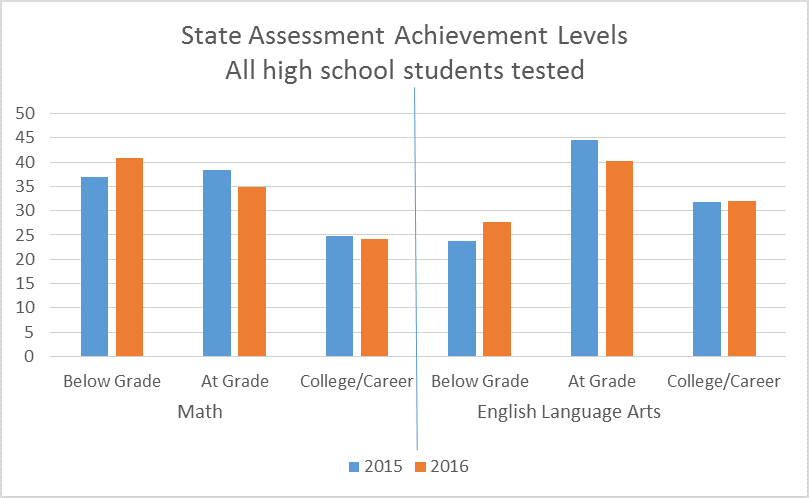There is an achievement crisis in the Kansas education system that must be reversed if our students are to be prepared for the demands of the dynamic work environments the future promises.
The Kansas State Department of Education tells us that in three short years, 71% of jobs in Kansas will require postsecondary education or training. However, according to KSDE, only about half of Kansans currently have education beyond high school. If we as a state are to adequately meet the demands that come with the need of a highly educated work force, young adults must have the requisite skills to be successful to continue their education after high school.
But is there really a crisis? Everyone from the governor to the education community to the media keeps telling us how great our schools are. The evidence suggests otherwise. Here is the latest state of achievement. You’d be hard-pressed to find these outcomes acceptable.
2016 State Assessment Results
The results of the 2016 Kansas state assessments are disappointing, to say the least. 2016 was the second year of post-No Child Left Behind testing, and designed to give a more honest assessment of student achievement. The chart provides a visual:
- 2 in 5 of Kansas 10th graders are below grade level in math.
- Only 1 in 4 10th graders are considered college/career ready in math, in English Language Arts (ELA), it’s 1 in 3.
- Overall, 2016 scores are lower than 2015, which is considered the baseline year.

As low as these proficiency numbers are, the income-based achievement gaps are even more disconcerting. A mere 11% of low-income 10th graders are college/career ready in math compared to 34% for the non-low-income students. In ELA, the numbers are 18% and 42%, respectively.
ACT Scores
Only 31% of Kansas high school students who chose to take the ACT are considered college-ready in the four core areas of English, reading, math and science. What does that really mean? It means that too many high school graduates must take remedial courses at the college level because high school didn’t prepare them for the rigors of college. The effect is that college gets more expensive, saddling students with more debt, and it takes longer to graduate.
National Assessment of Educational Progress (NAEP)
Over the past 15 years, the reading and math NAEP scores of 4th and 8th grades have been low, and as flat as western Kansas. Just 20% of low-income 4th graders are proficient in reading and 27% are proficient in math. A mere half of the students who are not low income are proficient in reading and math. Among the 8th graders less than a quarter of low-income kids are proficient in reading and math while less than half of the students who are not low income are proficient. With scores like these, is it any wonder our elementary and middle school students perform the way they do in high school?
More data on state assessments, ACT scores and NAEP can be found at kansasopengov.org.
Despite a real and persistent achievement crisis, there are those who believe we have a funding crisis. The prize they eye is not one of student success, it’s the number of dollars at their disposal. Per-pupil spending is north of $13,000 and continues to set records, but the attention is on getting more and more at the real expense of actual learning and outcomes.
The state gives virtual carte blanche to districts when it comes to how they spend their money. Given that and the low levels of achievement, here are some questions every local school board member should publicly answer:
1. Do you find these outcomes to be acceptable, and if not, what is acceptable?
2. If you believe schools are underfunded, what is the right number, how do you justify it and does that account for efficient use of taxpayer money?
3. If schools get that amount, when will outcomes be acceptable?
The right funding number, by the way, cannot be identified by resurrecting the old finance formula and simply “fully funding” it. That idea doesn’t fit the Supreme Court’s standards-based financing decision handed down in 2014 and funding wasn’t “reasonably calculated” to meet those standards.
Lobbying groups like KNEA, the Kansas Association of School Boards and the United School Administrators go to great lengths to make the public believe there is a correlation (even causation) between spending and outcomes. By perpetuating that charade they frame the discussion of outcomes (when they find themselves forced to talk about outcomes) in terms of funding. In their world view more money will lead to higher outcomes.
But that just isn’t true. There is no credible research that supports the theory that increasing the amount of money to education will improve student outcomes. Even those in the research community who support the idea of more money in the name of higher outcomes acknowledge that it’s how the money is spent that makes a difference – not how much.
Kansas can have great public education for all but not until current outcomes are acknowledged and student-focused corrective measures are taken.




